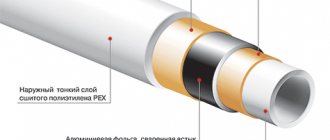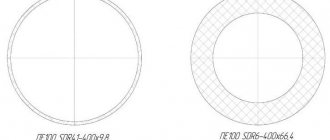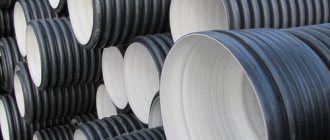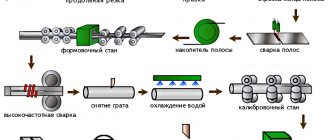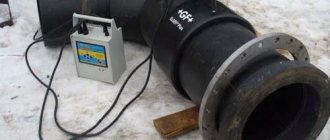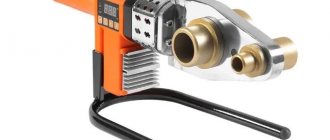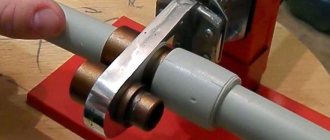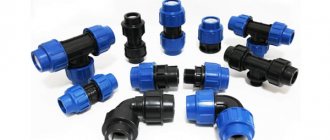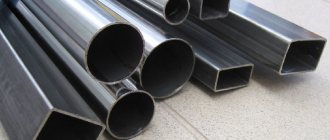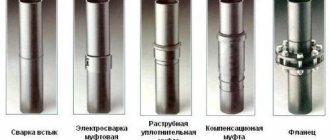Hi all!
According to official statistics, more than half of polymer pipes are produced from polyethylene worldwide. In Russia, polyethylene occupies an even larger share of this market. And every year the numbers increase, so the production of polyethylene pipes is both a proven and promising business.
I will briefly and clearly analyze the technological, legal, and financial features of polyethylene production. I’ll tell you about the market leaders, pitfalls, and give approximate lists of equipment and staff needed to start your own business.
Main characteristics of polyethylene pipes
There are 2 main types of polyethylene:
- HDPE – low-density polyethylene. Used for the manufacture of pipes, hoses, fittings, and household containers.
- LDPE – high-density polyethylene. Mainly used for the production of flexible packaging and bags.
To produce polyethylene products, you need a special machine - an extruder. In it, the loaded raw material is softened under temperature and pressed into the hole, forming the final appearance of the product. The brand and scope of application of pipes is determined by the following characteristics:
- operating pressure;
- operating temperature range;
- strength;
- wear resistance;
- resistance to aggressive environments (soil, groundwater).
Is it worth abandoning HDPE pipes due to rising costs?
Is it possible to completely replace this type of pipe products? The opinion is clear - no. It will not be possible to go back to the past, when we assessed the advantages of this particular type of material for the pipeline - the difference is too great. Oxidizing short-lived steel, durable and always expensive cast iron also do not cost within the pre-crisis prices, they become more expensive, but their characteristics do not change. We will also not be able to use the PVC on which America “sits” - there is a big difference in the characteristics. Even if there is no price adjustment, polyethylene will be sold as before, because the areas where it is used simply cannot live without it.
Areas of application of Russian HDPE pipes
The production of HDPE pipes is supported by the following industries:
- public utilities - repair of worn-out Soviet water supply and sewerage pipelines, arrangement of storm drains and drainage systems;
- private construction - organization of water supply, gasification, heating and wastewater disposal in a full cycle;
- industry – water supply, organization of recycling water supply systems, maintaining the operation of workshops, boiler houses, offices;
- agriculture - arrangement of irrigation systems, drainage and drying of soils, life support of field stations;
- gas industry – replacement of outdated gas supply systems with safe modern pipelines;
- road construction – soil stabilization with HDPE drainage systems.
The basis for such a wide range of uses is technical characteristics.
Properties of HDPE pipes
- Mechanical strength. The viscous and elastic material can withstand expansion due to freezing of water without loss of properties, does not burst at temperatures down to -400, which makes it convenient for installation in winter, and can withstand rough handling (does not break or bend when hitting the ground).
- Chemical resistance. Not subject to destruction by the influence of salts, alkalis and moderate acids.
- Biological purity. Does not support the growth of bacteria, the growth of films, the development of fungi and molds both inside and on the surface.
- Increase in throughput. As it is used, the internal wall becomes smoother, while rust forms on the steel and the gap becomes overgrown.
- Elasticity, resistance to water hammer. A small diameter pipe can withstand bending up to 20 of its own radii without breaking. Excess pressure is leveled by the elasticity of the wall, which returns to its original shape upon stabilization.
- Durability. The tested service life is 50 years, the estimated service life is 300 (tests were not carried out due to the small age of the product).
HDPE pipes are lightweight, they are easier to deliver to the work site and lower even without the involvement of super-heavy equipment. The installation technology of electrofusion or butt welding ensures uniformity of the pipe along its entire length without qualitatively changing the physical properties of the joints. The pipe does not require cathodic protection, and large-format corrugated pipe can be laid without a tray. All these properties allow us to say that the future of the product is stable.
When choosing a pipe production plant, give preference to reliable suppliers. Work to order, shipment of any batches, flexible payment terms and most importantly - certification, assistance in the delivery and installation of pipelines of any complexity - the basis for the quality of the finished pipeline.
Areas of application, advantages and disadvantages of polyethylene pipes
In addition to main installations, HDPE pipes are used for underfloor heating systems, drainage systems, waterproofing of thermal lines, and transportation of chemically aggressive liquids. Their main advantages:
- Wide operating temperature range (-60…+60 °C).
- Environmental friendliness. Polyethylene products are non-toxic and do not have a harmful effect on the environment.
- Anti-corrosion qualities.
- Resistance to mechanical stress.
- Long service life (up to 50 years).
- Elasticity (easy to bend).
- Easy to install.
- Convenient transportation and storage (stored in rolled-up coils).
- Lightweight polyethylene pipes compared to metal counterparts.
- Low cost compared to other materials.
At the same time, there are several properties that limit the use of HDPE:
- Instability to UV rays, therefore, for the operation of polyethylene pipes in an open sunny area, additional protection is required.
- Not used when installing fire drainage systems.
- At very high temperatures (from +80 °C), the polymer softens and deforms.
- Doesn't fit well with products made from other materials.
Features of installation of HDPE pipelines
Polyethylene pipelines are installed by butt welding or using fittings with electric embedded heaters. Welding requires not only special equipment, but also certification of personnel who are trained according to the standards of the National Welding Control Agency (NAKS) with the issuance of a certificate and periodic recertification.
For pipe products with a length of 110 mm, a simplified installation method using compression fittings can be used. This technology is simple and accessible even to people without education. The absence of complex equipment and thermal processes makes the work safe and does not require certification.
It is worth emphasizing that welded joints are permanent. They cannot be dismantled or opened if repair work is necessary. If there is a need to repair the insertion of a new branch, install a plug, etc., a new section is cut and soldered using a convenient method (for small diameters, when carrying out local work, fittings with heaters are most often used).
The butt method is used when laying large-diameter pipelines and carrying out large-scale work. This is partly due to the high cost of special fittings and a slightly longer work cycle. When installing pipes at home, in suburban residential buildings and even in factories, electrofusion welding is more convenient, since it can be carried out in extremely limited space.
The strength of the resulting joints is the same: the polymers have the same properties and form a joint that is identical in strength, regardless of the method of heating the joining zone.
Profitability of plastic pipe production
With a well-designed business process, polyethylene production should reach self-sufficiency within 2 years. At the very beginning, it is important to determine the product matrix, positioning, and target audience. For example, some companies focus exclusively on the end consumer and private housing construction.
Investments and income
As a rule, starting capital for polyethylene production starts from 8 million rubles. Equipment is purchased, production premises are rented, personnel are hired, working capital is generated, and a safety net is created for the first six months. The profitability of an enterprise depends on the region of location and the presence or absence of a competitive environment. According to statistics, profitability ranges from 2 to 20% of turnover.
Recruitment
Before starting production and hiring a team, you need to find premises with an area of at least 200 m2 with ceilings of 10 meters. This is due to the dimensions of the equipment, the need to store polyethylene material, the installation of additional ventilation, utility rooms and “cabins” (places for eating and resting).
To service a standard line you will need the following command:
- 6 workers, if production operates in 3 shifts, i.e. 2 people for each shift;
- 2 machine operators;
- 1 technologist;
- 1 accountant;
- at least 2 auxiliary workers who can work 8 hours a day;
- 2 cleaners;
- 1 driver;
- at least 1 manager.
A marketer is desirable - he will be involved in the promotion of polyethylene products on the market.
PE pipe from the factory. We work without intermediaries.
Our own production of technical PE pipes opens up wider horizons for the successful sale of products. The most tangible advantage that the absence of intermediaries promises is the lowest possible price (not only wholesale, but also retail). In addition, the established production of plastic pipes for cables allows us to work directly with the consumer, which is especially important when ordering products of a non-standard configuration.
Direct deliveries of PE pipes from the factory increase the degree of safety of products and reduce the costs of additional logistics operations: transportation, loading and unloading, warehousing, storage. Products from the manufacturer are a guarantee of quality, safety and reasonable price. In addition, you can always order a batch of pipe with unique parameters, which is not always available when working with intermediaries.
The experience gained as a result of the stable activities of our enterprise allows us to successfully form a base of permanent suppliers of recyclable materials who offer proven products. This approach serves as an additional guarantee of creating favorable conditions for obtaining a safe final product.
Scheme for obtaining a certificate of conformity
Depending on the product range, certification documents are obtained that confirm the quality of the manufactured products. To obtain a certificate, you must contact the authorized bodies with an application and a mandatory package of technical production documentation. The application can be submitted by a manufacturer or a distributor.
Before issuing a certificate, polyethylene products are checked for compliance with quality in accordance with GOSTs. Inspection tests are regulated by state regulations and standards.
General information
Pipes are one of the most popular plastic products.
They can be made from almost any polymer material, but are most often made from polypropylene (PP), polyethylene (PE) and polyvinyl chloride (PVC). Fiberglass products are used less frequently. Fittings must also be produced from the same polymers so that their chemical nature does not differ from the linear product and can form a strong welded or adhesive connection with it. Polymer pipes are usually used for cold and hot water supply, sewerage, field irrigation, drainage and drains. Standard range of plastic pipeline diameters: 12, 16, 20, 25, 32, 40, 50, 63, 75, 90, 110, 125 mm and more. Wall thicknesses may vary depending on the purpose, material and internal operating pressure.
Polyethylene pipes are produced from high-density polyethylene (HDPE) and its varieties PE-63, PE-80 and PE-100, etc. and cross-linked polyethylene (PEX). Such products are used for water supply (usually external), as well as for the outer shell of pipes in polyurethane foam insulation. Polypropylene pipes made from propylene homopolymer (often recycled) are used, as a rule, for internal sewerage. By extruding random polypropylene copolymer, pressure products for cold or hot water supply are obtained, which are however also usually used inside buildings. Polyvinyl chloride pipes and fittings are most often used for laying sewerage outside buildings and structures. A relatively small number of pressure pipes and drainage systems are also made from PVC.
In addition to purely plastic ones, there are composite pipes. The most important of them are metal-plastic products, a type of plastic inside and outside with a metal layer inside, as well as pipes and fittings in polyurethane foam (PPU) insulation. Polyurethane foam is usually poured into the space between the inner working pipe and the outer protective shell. Interestingly, both the pipe and the shell can be either polymer (usually polyethylene) or metal. However, the most commonly used version of this type is a steel pipe and black HDPE sheath for laying networks in the ground. Metal-plastic pipelines are used for heating and for water supply or gas supply to buildings.
Also, pipes made of various polymers can be corrugated. Due to their much higher flexibility, they are used primarily in networks where it is necessary to bend highways with a small radius, as well as in three-dimensional systems. In particular, corrugated pipes are used as hoses for sewerage purposes or for laying utility systems in sewers.
Fig.1. Corrugated pipes
Necessary equipment
A significant cost item for in-house production is equipment. Prices for it depend on the country of origin, the functionality of the machines, as well as the time of their use if used machines are purchased.
To produce polyethylene water and gas supply pipes and cable sheaths you will need:
- pellet dryer;
- forklift;
- extruder;
- vacuum calibrator;
- bath for cooling workpieces in it;
- conveyor;
- coronator;
- planetary saws;
- marker;
- automatic stacker;
- automatic control system.
Free-pressure pipes for cable drainage.
Black HDPE pipes can be used to install cable ducts and free-flow drainage systems. The chemical resistance of polyethylene allows them to effectively serve in storm drainage structures, main conduits, local and global networks. Thanks to optimal performance characteristics (minimum weight, elasticity, strength, corrosion resistance, etc.), non-pressure PE pipes are confidently replacing analogues made from steel and asbestos-cement materials.
A long service life is guaranteed if the operating conditions of the pipes are met. For example, the use of polyethylene pipes for the circulation of liquids with pressure levels above 0.4-0.5 MPa is prohibited, and the material is also not suitable for transporting liquids with temperatures exceeding 40 degrees.
What is used as raw material
For production use:
- various polymer materials;
- polyethylene;
- PVC – polyvinyl chloride;
- polypropylene.
The choice of raw materials depends on the purpose of the product line being produced. Hastalen 5416 (Bazell) and Vestalen 9412 (SABIC) are the most famous foreign brands that supply products to our country.
Manufacturing process
The production of polyethylene pipe is as follows:
- After filling the granulated raw material, it melts and is fed into the extruder head.
- In the extruder head, the molten mass is pressed under pressure into a special hole, and a pipe is formed from the “polymer dough”.
- The workpiece is slightly cooled and sent for vacuum calibration, where the diameter is adjusted to the nearest millimeter.
- After calibration, the workpiece is lowered into a cooling bath.
- Using a planetary saw, the polyethylene blank is cut into finished products according to the technical specifications.
Finished products are marked, their quality is checked, and then stored if no comments are found. If inconsistencies are found, the finished products are rejected.
Estimated price of production line
Here it is worth considering the prices directly for the lines of the extruder and auxiliary equipment for the production of HDPE, PVC and other pipes, since these technological units are the main ones.
You can get acquainted with the estimated cost of lines for the preparation of plastic waste in the relevant sections on equipment in this article.
The leaders on the Russian market are representatives of Chinese companies. European models are also widely represented. For a manufacturer with minimal experience, their choice should be Asian-made machines.
The line price usually includes:
- extruder (single screw or twin screw);
- die (of a given diameter);
- calibrator;
- cooling, pulling and cutting devices.
| Trade company | Price |
| AsiaPlast (Dzerzhinsk) | 35-120 thousand dollars |
| InsTerra (Chelyabinsk) | 980 thousand rubles |
| TechnoPlast (Tomsk) | 3650 thousand rubles. |
| World Equipment (Podolsk) | 5585 thousand rubles. |
| Winter Delta (Krasnodar) | 3650 thousand rubles. |
Such a wide range of prices is explained by the different productivity of the machines. Conventionally, more expensive machines produce a larger volume of finished products per hour (in linear meters) and are more automated in control.
The presented equipment is quite versatile and can be used for the production of polyethylene and other pipes of various diameters, as well as for the production of other molded products.
Transportation and storage rules
Transportation and storage are those stages of production where they try to save money, which often means spoiled material. Remember that storing and transporting polyethylene pipe correctly is just as important as making it correctly.
When transporting and storing pipes, I recommend:
- Use only serviceable vehicles with a long wheelbase so that the pipe does not hang in the air.
- Store pipes on a flat and clean surface to prevent mechanical damage.
- Do not make stacks higher than 2 m. For short-term storage of up to 2 months, the stack height can be increased to 3 m.
- When transporting by water, use sealed packaging.
- When transporting goods by rail, observe weight standards and carefully load products into the train.
Pipe production in Russia: fast, high quality and inexpensive.
Fast, high quality, inexpensive. Previously, in the production of polymer pipes, something had to be crossed out. For example, there are companies that are ready to fulfill a large order in a short time, but at the same time, the price will be much higher than average. Alternatively, you can save on quality, although it is better not to do this. Most large customers are forced to wait to get good pipes at a low price. Sometimes it is possible to buy imported polymer pipes with a good price-quality ratio, but, as a rule, they are either not available at all, or the stocks are too small.
Recently everything has changed. Pipe production in Russia has begun to widely adopt new generation equipment that significantly reduces costs. Our company was one of the first to install modern devices capable of creating more meters of pipe in one unit of time. Thus, it became possible to produce pipes that are of good quality, at a lower cost, and production times are reduced. All this allows us to provide favorable conditions for all categories of customers.
Russian leaders
There are domestic and foreign polyethylene products on the Russian construction market. Leaders in this field:
- Eurotrubplast is a united group of companies. It occupies about 20% of the total polyethylene pipe products market.
- Kazanorgsintez is the group's main competitor. It produces a wide range of products and also holds about 20% of the market. Products comply with modern international standards.
- “TehStroyPolymer” is a wide-ranging company, in addition to polyethylene pipes and shaped HDPE products, it produces welding equipment.
- "PolyPlastic" - the association includes subsidiaries throughout the CIS, as well as a design institute and a scientific and technical production control center located in the northern capital. The company organized a full cycle production from receiving granulate to supplying pipes.
PIPE CATALOG
For convenience, prices are listed by diameter, click on the one you need.
63 mm 75 mm 90 mm 110 mm 125 mm 140 mm 160 mm 180 mm 200 mm 225 mm 250 mm 315 mm
